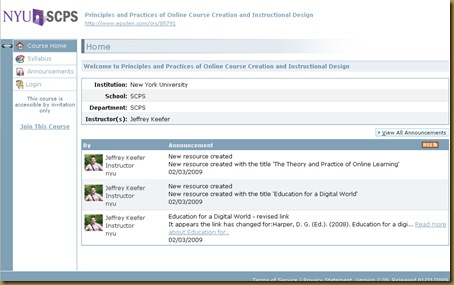One of the ongoing assignments for my students will be to blog:
Course Blogs
Reflective Practice is a critical aspect of teaching and learning, and a fundamental element of teaching online involves acquiring a comfort with technology to communicate and collaborate.
Online learning is a more networked experience than traditional face-to-face (F2F) learning. Thus, students are required to use a blog for this course. Students may use their own blog (if they have one) or create a new one (Blogger, WordPress.com, or elsewhere). Blog posts should be done at least once a week discussing some learning or a reaction to anything in the course.
Making at least two comments every week on other course attendee blogs is required.
Let me set an example for our first posting!

I will comply with your requirement (i.e. make at least 2 comments every week on other course attendee blog). So I will give a try now!
Thanks for teaching us this online, interactive course. This is fun and yet challenging! One of the main challenges for the presenter, is to keep the audience awake and engaged. This is a tough one as emotions need to be conveyed differently and body language is almost non existent. But congrats so far!
@Anne
Thank you for the vote of confidence and encouragement!
I think you are right about engagement; that is the key to all teaching and learning–engaged learners learn best! The trick is, how does that work online?!
Well, having short talks and asking questions to students, their opinion on a topic, launching a poll, etc.
ok, third time and have lost everything I typed….
I guess third time its a charm….
Jeffrey,
Thank you for teaching this online course and looking forward to more interesting topics. I enjoy reading blogs from true trainers.
Hmmm…. thought I’d left a comment here after class. OK, take 2:
Designing an effective online course:
One of the best aspects of this course is something you mentioned in the first class: the opportunity to experiment.
Those of us with experience on teaching online courses may or may not be willing to try something new in the middle of a course. The potential train wreck could derail the learning process for our students, undoing a lot of effort. Yet, I, at least beleive there are issues with current established practices that need to change.
Our current readings for this week also deal with the changes as online learning, or eLearning, has developed, so I’ll be discussing that issue in my blog this week. Feel free to drop in and add your thoughts as we all work toward perfecting our tools and practices! (http://russgifford.wordpress.com)
Hi Jeffrey
I’ve enjoyed your course thus far and look forward to the coming weeks. I agree with Anne, in that engagement during online instruction will be the most challenging aspect of instructional learning. You seem to have managed it well and it certainly makes a big difference for me to be able to see you.
As a participant, I prefer to write in the chat box with questions, comments and general interaction with other team members. I guess this manifests itself in my preference for using text as opposed to the telephone. As the presenter/ facilitator of the group, how do you find this method of communication? I find the whole hands up, press and hold the button somewhat laborious. My guess is that some of my participants will feel the same way.
During this course you have been using Wilba and I’ve just started to use Webex at my work place. I imagine Wilba to be as expensive and as limiting as Webex. Consequently, I wonder what other programs are out there that are not expensive and that perhaps allow mash-up presentation without the drop outs of sound and video and the limitations of the aforementioned programs?
Zane Rhodes
Amazing blog page. So this is what it is all about. Bonnie
@Edna
@Bonnie Wasserman
@Zane Rhodes
@Russell Gifford
@Anne
Thank you all for your comments. Now, a few days (at least) after most of you posted these, I hope our course is not only meeting your expectations, but helping you to envision new ones!